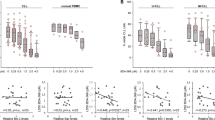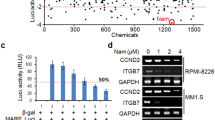Abstract
The inhibitor of apoptosis (IAP) proteins have a critical role in the control of apoptotic machinery, and has been explored as a therapeutic target. Here, we have examined the functional importance of IAPs in multiple myeloma (MM) by using a Smac (second mitochondria-derived activator of caspases)-mimetic LCL161. We observed that LCL161 was able to potently induce apoptosis in some MM cell lines but not in others. Examining the levels of X-linked inhibitor of apoptosis protein (XIAP), cellular inhibitor of apoptosis protein 1 (cIAP1) and cellular inhibitor of apoptosis protein 2 (cIAP2) post LCL161 treatment indicated clear downregulation of both XIAP activity and cIAP1 levels in both the sensitive and less sensitive (resistant) cell lines. cIAP2, however, was not downregulated in the cell line resistant to the drug. Small interfering RNA-mediated silencing of cIAP2 significantly enhanced the effect of LCL161, indicating the importance of downregulation of all IAPs simultaneously for induction of apoptosis in MM cells. LCL161 induced marked up regulation of the Jak2/Stat3 pathway in the resistant MM cell lines. Combining LCL161 with a Jak2-specific inhibitor resulted in synergistic cell death in MM cell lines and patient cells. In addition, combining LCL161 with death-inducing ligands clearly showed that LCL161 sensitized MM cells to both Fas-ligand and TRAIL.
This is a preview of subscription content, access via your institution
Access options
Subscribe to this journal
Receive 12 print issues and online access
$259.00 per year
only $21.58 per issue
Buy this article
- Purchase on SpringerLink
- Instant access to full article PDF
Prices may be subject to local taxes which are calculated during checkout






Similar content being viewed by others
References
Cotter TG . Apoptosis and cancer: the genesis of a research field. Nat Rev Cancer 2009; 9: 501–507.
Kim I, Xu W, Reed JC . Cell death and endoplasmic reticulum stress: disease relevance and therapeutic opportunities. Nat Rev Drug Discov 2008; 7: 1013–1030.
Reed JC . Bcl-2-family proteins and hematologic malignancies: history and future prospects. Blood 2008; 111: 3322–3330.
Yip KW, Reed JC . Bcl-2 family proteins and cancer. Oncogene 2008; 27: 6398–6406.
Fulda S, Vucic D . Targeting IAP proteins for therapeutic intervention in cancer. Nat Rev Drug Discov 2012; 11: 109–124.
Salvesen GS, Duckett CS . IAP proteins: blocking the road to death's door. Nat Rev Mol Cell Biol 2002; 3: 401–410.
Eckelman BP, Salvesen GS, Scott FL . Human inhibitor of apoptosis proteins: why XIAP is the black sheep of the family. EMBO Rep 2006; 7: 988–994.
Bertrand MJ, Milutinovic S, Dickson KM, Ho WC, Boudreault A, Durkin J et al. cIAP1 and cIAP2 facilitate cancer cell survival by functioning as E3 ligases that promote RIP1 ubiquitination. Mol cell 2008; 30: 689–700.
Varfolomeev E, Goncharov T, Fedorova AV, Dynek JN, Zobel K, Deshayes K et al. c-IAP1 and c-IAP2 are critical mediators of tumor necrosis factor alpha (TNFalpha)-induced NF-kappaB activation. J Biol Chem 2008; 283: 24295–24299.
Chai J, Du C, Wu JW, Kyin S, Wang X, Shi Y . Structural and biochemical basis of apoptotic activation by Smac/DIABLO. Nature 2000; 406: 855–862.
Liu Z, Sun C, Olejniczak ET, Meadows RP, Betz SF, Oost T et al. Structural basis for binding of Smac/DIABLO to the XIAP BIR3 domain. Nature 2000; 408: 1004–1008.
Wu G, Chai J, Suber TL, Wu JW, Du C, Wang X et al. Structural basis of IAP recognition by Smac/DIABLO. Nature 2000; 408: 1008–1012.
Desplanques G, Giuliani N, Delsignore R, Rizzoli V, Bataille R, Barille-Nion S . Impact of XIAP protein levels on the survival of myeloma cells. Haematologica 2009; 94: 87–93.
Mitsiades CS, Mitsiades NS, Richardson PG, Munshi NC, Anderson KC . Multiple myeloma: a prototypic disease model for the characterization and therapeutic targeting of interactions between tumor cells and their local microenvironment. J Cell Biochem 2007; 101: 950–968.
Keats JJ, Fonseca R, Chesi M, Schop R, Baker A, Chng WJ et al. Promiscuous mutations activate the noncanonical NF-kappaB pathway in multiple myeloma. Cancer Cell 2007; 12: 131–144.
Annunziata CM, Davis RE, Demchenko Y, Bellamy W, Gabrea A, Zhan F et al. Frequent engagement of the classical and alternative NF-kappaB pathways by diverse genetic abnormalities in multiple myeloma. Cancer Cell 2007; 12: 115–130.
Nakagawa Y, Abe S, Kurata M, Hasegawa M, Yamamoto K, Inoue M et al. IAP family protein expression correlates with poor outcome of multiple myeloma patients in association with chemotherapy-induced overexpression of multidrug resistance genes. Am J Hematol 2006; 81: 824–831.
Chauhan D, Neri P, Velankar M, Podar K, Hideshima T, Fulciniti M et al. Targeting mitochondrial factor Smac/DIABLO as therapy for multiple myeloma (MM). Blood 2007; 109: 1220–1227.
Ramakrishnan V, Timm M, Haug JL, Kimlinger TK, Wellik LE, Witzig TE et al. Sorafenib, a dual Raf kinase/vascular endothelial growth factor receptor inhibitor has significant anti-myeloma activity and synergizes with common anti-myeloma drugs. Oncogene 2010; 29: 1190–1202.
Ramakrishnan V, Ansell S, Haug J, Grote D, Kimlinger T, Stenson M et al. MRK003, a gamma-secretase inhibitor exhibits promising in vitro pre-clinical activity in multiple myeloma and non-Hodgkin's lymphoma. Leukemia 2012; 26: 340–348.
Ramakrishnan V, Kimlinger T, Haug J, Painuly U, Wellik L, Halling T et al. Anti-myeloma activity of Akt inhibition is linked to the activation status of PI3K/Akt and MEK/ERK pathway. PLoS One 2012; 7: e50005.
Chou TC, Talalay P . Quantitative analysis of dose–effect relationships: the combined effects of multiple drugs or enzyme inhibitors. Adv Enzyme Regul 1984; 22: 27–55.
Bianchi G, Kumar S, Ghobrial IM, Roccaro AM . Cell trafficking in multiple myeloma. Open J Hematol 2012; 3 (Suppl 1)): pii 4.
Manier S, Sacco A, Leleu X, Ghobrial IM, Roccaro AM . Bone marrow microenvironment in multiple myeloma progression. J Biomed Biotechnol 2012; 2012: 157496.
Imre G, Larisch S, Rajalingam K . Ripoptosome: a novel IAP-regulated cell death-signalling platform. J Mol Cell Biol 2011; 3: 324–326.
Jouan-Lanhouet S, Arshad MI, Piquet-Pellorce C, Martin-Chouly C, Le Moigne-Muller G, Van Herreweghe F et al. TRAIL induces necroptosis involving RIPK1/RIPK3-dependent PARP-1 activation. Cell Death Differ 2012; 19: 2003–2014.
Ozoren N, El-Deiry WS . Defining characteristics of Types I and II apoptotic cells in response to TRAIL. Neoplasia 2002; 4: 551–557.
Varfolomeev E, Blankenship JW, Wayson SM, Fedorova AV, Kayagaki N, Garg P et al. IAP antagonists induce autoubiquitination of c-IAPs, NF-kappaB activation, and TNFalpha-dependent apoptosis. Cell 2007; 131: 669–681.
Fan Y, Mao R, Yang J . NF-kappaB and STAT3 signaling pathways collaboratively link inflammation to cancer. Protein Cell 2013; 4: 176–185.
Ramakrishnan V, Kimlinger T, Haug J, Timm M, Wellik L, Halling T et al. TG101209, a novel JAK2 inhibitor, has significant in vitro activity in multiple myeloma and displays preferential cytotoxicity for CD45+ myeloma cells. Am J Hematol 2010; 85: 675–686.
Scuto A, Krejci P, Popplewell L, Wu J, Wang Y, Kujawski M et al. The novel JAK inhibitor AZD1480 blocks STAT3 and FGFR3 signaling, resulting in suppression of human myeloma cell growth and survival. Leukemia 2011; 25: 538–550.
Guicciardi ME, Gores GJ . Life and death by death receptors. FASEB J 2009; 23: 1625–1637.
Lu J, McEachern D, Sun H, Bai L, Peng Y, Qiu S et al. Therapeutic potential and molecular mechanism of a novel, potent, nonpeptide, Smac mimetic SM-164 in combination with TRAIL for cancer treatment. Mol Cancer Therap 2011; 10: 902–914.
Geserick P, Hupe M, Moulin M, Wong WW, Feoktistova M, Kellert B et al. Cellular IAPs inhibit a cryptic CD95-induced cell death by limiting RIP1 kinase recruitment. J Cell Biol 2009; 187: 1037–1054.
Demchenko YN, Glebov OK, Zingone A, Keats JJ, Bergsagel PL, Kuehl WM . Classical and/or alternative NF-kappaB pathway activation in multiple myeloma. Blood 2010; 115: 3541–3552.
Petersen SL, Peyton M, Minna JD, Wang X . Overcoming cancer cell resistance to Smac mimetic induced apoptosis by modulating cIAP-2 expression. Proc Natl Acad Sci USA 2010; 107: 11936–11941.
Darding M, Feltham R, Tenev T, Bianchi K, Benetatos C, Silke J et al. Molecular determinants of Smac mimetic induced degradation of cIAP1 and cIAP2. Cell Death Differ 2011; 18: 1376–1386.
Vince JE, Wong WW, Khan N, Feltham R, Chau D, Ahmed AU et al. IAP antagonists target cIAP1 to induce TNFalpha-dependent apoptosis. Cell 2007; 131: 682–693.
Chauhan D, Uchiyama H, Akbarali Y, Urashima M, Yamamoto K, Libermann TA et al. Multiple myeloma cell adhesion-induced interleukin-6 expression in bone marrow stromal cells involves activation of NF-kappa B. Blood 1996; 87: 1104–1112.
Catlett-Falcone R, Landowski TH, Oshiro MM, Turkson J, Levitzki A, Savino R et al. Constitutive activation of Stat3 signaling confers resistance to apoptosis in human U266 myeloma cells. Immunity 1999; 10: 105–115.
Liu M, Guo S, Stiles JK . The emerging role of CXCL10 in cancer (Review). Oncol Lett 2011; 2: 583–589.
Luster AD, Ravetch JV . Biochemical characterization of a gamma interferon-inducible cytokine (IP-10). J Exp Med 1987; 166: 1084–1097.
Gutierrez-Vazquez C, Villarroya-Beltri C, Mittelbrunn M, Sanchez-Madrid F . Transfer of extracellular vesicles during immune cell-cell interactions. Immunol Rev 2013; 251: 125–142.
Luo JL, Kamata H, Karin M . IKK/NF-kappaB signaling: balancing life and death—a new approach to cancer therapy. J Clin Invest 2005; 115: 2625–2632.
Knights AJ, Fucikova J, Pasam A, Koernig S, Cebon J . Inhibitor of apoptosis protein (IAP) antagonists demonstrate divergent immunomodulatory properties in human immune subsets with implications for combination therapy. Cancer Immunol Immunother 2013; 62: 321–335.
Sauer M, Reiners KS, Hansen HP, Engert A, Gasser S, von Strandmann EP . Induction of the DNA damage response by IAP inhibition triggers natural immunity via upregulation of NKG2D ligands in Hodgkin lymphoma in vitro. Biol Chem 2013; 394: 1325–1331.
Yang C, Davis JL, Zeng R, Vora P, Su X, Collins LI et al. Antagonism of inhibitor of apoptosis proteins increases bone metastasis via unexpected osteoclast activation. Cancer Disc 2013; 3: 212–223.
Acknowledgements
We would like to acknowledge Kimberly Henderson, Roberta DeGoey and Beatrice Hartke for their assistance with processing of tumor cells and all of the patients who provided us with the tumor samples. This study was supported in part by Hematological Malignancies Program (Mayo Clinic Cancer Center); and CA90628 (SK) from National Cancer Institute. LCL161 was synthesized and provided by Novartis (Basel, Switzerland) under a Material Transfer Agreement (MTA).
Author information
Authors and Affiliations
Corresponding author
Ethics declarations
Competing interests
SK: research support from Celgene, Millennium, Novartis, Merck, Cephalon, Genzyme and Bayer. SK: advisory board-Merck.
Additional information
Supplementary Information accompanies this paper on the Leukemia website
Rights and permissions
About this article
Cite this article
Ramakrishnan, V., Painuly, U., Kimlinger, T. et al. Inhibitor of apoptosis proteins as therapeutic targets in multiple myeloma. Leukemia 28, 1519–1528 (2014). https://doi.org/10.1038/leu.2014.2
Received:
Accepted:
Published:
Issue Date:
DOI: https://doi.org/10.1038/leu.2014.2
Keywords
This article is cited by
-
BRCA mutations lead to XIAP overexpression and sensitise ovarian cancer to inhibitor of apoptosis (IAP) family inhibitors
British Journal of Cancer (2022)
-
1H, 13C and 15N resonance assignments of the first BIR domain of cellular inhibitor of apoptosis protein 1
Biomolecular NMR Assignments (2022)
-
Kaempferol mitigates Endoplasmic Reticulum Stress Induced Cell Death by targeting caspase 3/7
Scientific Reports (2018)
-
Overexpression of RKIP and its cross-talk with several regulatory gene products in multiple myeloma
Journal of Experimental & Clinical Cancer Research (2017)
-
Inhibitors of apoptosis: clinical implications in cancer
Apoptosis (2017)



